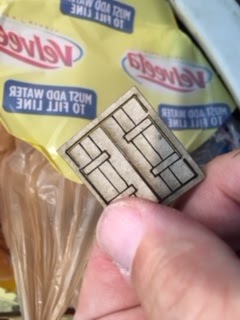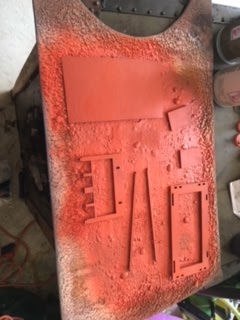Be warned this is a photo heavy post. So proceed only if you (and your band width) dare!!
Here is the building out of the shrink wrap. Two full sheets of MDF, one sheet of 1mm gray board (a.k.a. trash board imo) and two extra pieces of 3mm mdf (the two floors on the right). Once again there are no directions included, but they are available on the company website.
Here I have removed most of the parts from the sheets and organized them up by what colors they will be painted. In the front on the left is the brown pile, then the White pile, then the salmon pile. In the back the 1mm gray board still on the sheet will be painted limestone, the pile of walls in the back right will be painted partially red and partially white as it has exposed bricks. In the center is the actual store front which at this point I had not decided what to paint, but eventually it ended up on the salmon pile.
Here is a close up of the limestone pile, the corner blocks, some other stone trim and the counter at from the store front window.
Her is the brown pile: shutters, the upstairs floor, some bracings and two bonus crates provided in the kit.
Here is the white pile, walls and gables.
This is the Salmon pile, the main roof support, the roof side rails and the doors. Since the company takes a big cut out of the roof, it always amuses me that they bother to leave an even larger piece of MDF still in the roof plate, but be that as it may.
This is the first floor walls, all of which have exposed brick work so will end up painted red for the bricks and white for the stucco.
Here on the left is the store front window and a small pocket knife I got when my father passed away many years ago. I have always kept it at my desk and do not carry it around as I do not want to lose it. It only has two fold outs, a small knife and a nail file. The nail file is what is of interest here as I use it HEAVILY in all these mdf construction projects.
This is one of the side walls. When the laser (MAN do I want to do air quotes as I type that!) is used to cut out the part at two points on each piece the mdf is left uncut to keep the model piece in the mdf sheet for transport and storage. Those uncut pieces in variably end up leaving a little tuft of mdf behind when the piece is separated from the sheet. It is IMPERATIVE that these "harmless" bits get removed before construction else the entire project will suffer from gaps and cracks in the assembly. Some might ask "why not use an exacto knife to separate the parts from the sheet. Those people own stock in Exacto! Remember that mdf is basically just really dense paper. Nothing dulls a bladé like paper, now imagine that paper on steroids. A standard "hobby knife" is dulled to useless before finishing a kit this size. So unless you plan on adding a hobby knife per kit you build to your parts list, the exacto is exactly NOT the way to go!
Enter my father's old nail file. I file the tuft of mdf (that is probably the best term for them as they feel pretty soft at this stage and it is tempting to ignore them but DON"T) over the trash can (you will see why).
And Voila! No more tuft!
The 1mm gray board is worse than the mdf for the impact of the tufts so it too needs a treatment.
Once again Voila! The tuft is no more. Now I know that this seems like a pretty simple system and action, but remember that EACH piece has two of these tufts on them. There are 23 pieces of 3mm mdf in this kit, and 32 pieces of that accursed 1mm gray board. That gentle readers manufacturers 110 things that have to be filed in this one kit! It ends up being a lot of hassle.
Now I know that my simply telling some of you that you NEED to do this will result in you wondering why? You could ignore me and find out just how much of a problem this leads to (and some of you will), here I will show you what happens. This is the inside of the roof plate. There is no fitting that will happen here and it is almost completely out of sight so I will leave one of these little blighters on and show the results.
Here is that same little tuft of mdf. HOWEVER, that tuft of mdf has now absorbed the paint and dried. It is as hard as rock and connected to the paint so trying to remove after painted tends to screw up the paint and require recoats. If not removed two of these little nubs will easily prevent two pieces from properly fitting, even one will cause gaps in the fit. The glue tends to cover up these gaps as it dries and then reveal them after the glue has cured making them even harder to cover up. If you end up with these my suggestion is to add more glue, cover the entire gap, allow to dry then paint over and pay closer attention in the prep stage next time.
Remember I said you would see why you should do this over a trash can, take a close look at that piece of paper towel. Filed mdf has a tendency to settle and make a very grainy floor, which does not sweep up well. File over the trash can.
Now you are ready to start the painting. Here I have laid out all of the parts that are getting painted salmon. When I paint the parts I start by painting the back side first. I give the back only a single of paint coat. You do not "have" to paint the back, but I find that some of the parts end up showing their bottoms (naughty little buggers) in the finished product so its either figure out where that will happen and paint those parts or just be safe and paint them all. The one piece that NEEDS the back painted in any larger piece of accursed 1mm gray board. If the back is not painted there is a very bad tendency for the piece to fold up at the ends making attaching more difficult. Be very gentle with painting the back of the accursed 1mm gray board as if you put on too much paint the piece will shrink when it dries causing a different headache.
Here are the pieces painted on their back side.
After turning the pieces over, but before painting the second side you need to crease the roof sheet other wise it has a bad habit of not gluing down very well when the time arrives.
Next up I happened to grab the brick faced pieces. while waiting for coats to dry, The front side of pieces I give two coats to as rich color only comes from adding the paint. you can pick either part to paint first, but all you do is pick one of the colors and use painters tape to mask off one part of the wall.
Which results in something like this. The exposed mdf will be painted white and the covered will be painted later and a different color.
And now all four main floor walls have the bricks covered and the stucco ready to be painted.
By then it is time to go back and add the second coat to the front side of the pieces. Generally the Ubermatte paint I have been recommending through out these projects is completely dried in about 10-15 minutes on a Michigan summer afternoon so the recoatings go pretty fast.
Next the White pieces need to be painted. You can just see the painters tape showing through the white paint on the top four wall pieces.
Pardon the shadows, but here are the brown items.
Here is the accursed 1mm gray board with most pieces getting painted limestone along with the countertop. Due to the fact that these pieces are being glued up to a wall there is no need to paint the backs.
Finally, here is the bricks getting their paint. The painters tape has been removed from the exposed brick and the white walls are covered with new painters tape now.
Here is the finished store from the front.
.
Here is the right side (viewers perspective).
Here is the back.
And here is the left side (again viewers perspective.
Well that is all for now, but there will be a couple more articles as I work my way through these kits.
































No comments:
Post a Comment